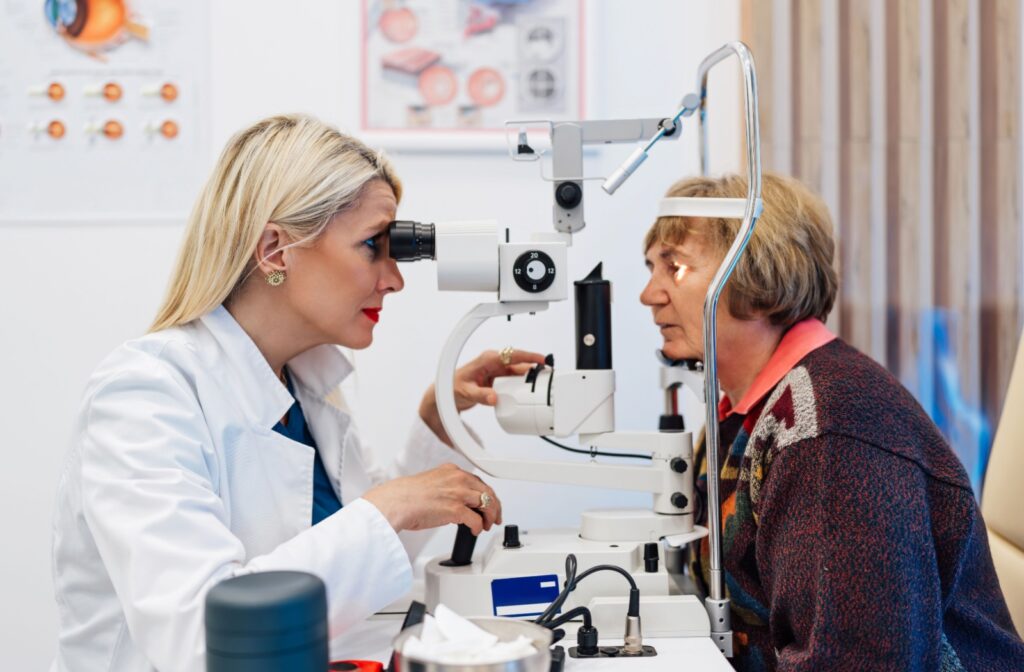Notice your vision getting blurrier or struggling to read small text? Or maybe you feel like the world around you is a little less crisp. Changes in your vision can be worrying, but they’re also common, especially as we get older.
Changes in your eyesight can happen for a variety of reasons, including:
- Presbyopia or refractive errors
- Cataracts
- Age-related macular degeneration (AMD)
- Glaucoma
The only way to know the cause of vision changes for sure is through a routine eye exam. Staying on top of these regular visits can help make visual changes feel less severe.
Presbyopia & Other Refractive Errors
One of the most common reasons for worsening eyesight, especially as you grow older, is presbyopia. This condition affects your ability to focus on close-up objects. It’s one of the primary reasons people switch to multifocal eyeglasses.
There’s no reason to worry about presbyopia. It’s a natural part of aging that most people experience at about 40 years old. It occurs because the eye’s lens becomes less flexible over time, making it harder to focus on tasks like reading a book or checking your phone.
Symptoms that accompany presbyopia include:
- Difficulty reading small print, such as books or labels
- The need to hold reading materials farther away to see clearly
- Eye strain or headaches after reading or doing close-up tasks
- Blurry vision when reading at a normal distance
Not to worry! Presbyopia is very easy to manage with the right corrective lenses. Bifocal readers are a classic choice, but many people prefer progressive lenses’ seamless look and transition.
Other refractive errors (myopia, astigmatism, hyperopia) can also contribute to visual concerns; however, they typically manifest during your childhood or adolescent years. That said, it’s normal for your vision to change with time; all it takes is a prescription update.
Signs that indicate your vision is changing because of a refractive error include:
- Difficulty reading fine print
- Blurred vision at a particular distance (near or far)
- Glares or halos, especially when driving at night
- Eye strain or headaches after focusing for too long
Cataracts
When you have cataracts, your vision becomes increasingly dull and hazy, almost as if you’re looking through a foggy window.
Cataracts also develop naturally with age. They occur when the eye’s natural lens becomes cloudy, making it harder for light to enter the eye.
The lens of the eye clouds gradually, making cataracts easy to overlook until symptoms start interfering with your daily life. Updating your vision prescription won’t help in this case, since it doesn’t address the changes in the eye’s lens.
Symptoms of cataracts include:
- Cloudy or blurry vision
- Increased sensitivity to light or glare
- Colours appearing faded or yellowish
- Difficulty seeing at night
While cataracts are more common in older adults, other factors such as smoking, certain medications, excessive sun exposure, or certain health conditions like diabetes can speed up their development.
The good news is that cataracts are very treatable with surgery! It’s a simple, safe, and very successful procedure that fully restores your vision. We often recommend cataract surgery when the clouding of the eye’s lens becomes severe, affecting your ability to perform daily tasks or your overall quality of life.

Age-Related Macular Degeneration (AMD)
Our field of vision is wide, and we can break it up into two different ways: central and peripheral vision. Central vision is sharp and precise, allowing us to see details right in front of us, like texture, words, or facial features.
The macula is a structure in the retina, responsible for central vision. Age-related macular degeneration is a progressive condition that damages the macula. When it deteriorates, you might notice blurry patches or blank spots in your vision.
There are two types of AMD: Dry (more common and progresses slowly) and Wet (rare but sudden and severe). Despite their differences, they have overlapping symptoms in the early stages:
- Difficulty recognising faces
- Straight lines appearing wavy
- Blurry areas in your central vision
Though AMD is primarily associated with aging, genetics, and lifestyle factors like smoking and poor diet can also contribute to its development.
We have yet to find a cure for AMD, however, we can manage the condition and slow its progression. Early detection encourages timely intervention, safeguarding your sight for longer.
Glaucoma
Peripheral vision is your “side vision”. A quick comparison shows (try for yourself) that your peripheral vision is not as sharp or fine as central vision, but it’s valuable nonetheless.
Glaucoma affects your peripheral vision, causing irreversible damage without timely intervention. It’s a condition where the optic nerve is progressively damaged causing irreversible vision. While there are different types of glaucoma, the most common is open-angle glaucoma, which develops gradually and without pain.
Warning signs of glaucoma include:
- Gradual loss of peripheral vision (side vision)
- Tunnel vision in advanced stages
- Severe eye pain and nausea (in cases of acute glaucoma)
Routine eye exams are vital for catching glaucoma early, as symptoms may not become noticeable until significant vision loss has already occurred.
Take Control of Your Vision
Some driving factors behind visual changes are nothing to worry about, but eye conditions such as AMD and glaucoma are much more serious. Adding to this challenge (since there is no cure for either condition) is that they don’t show obvious symptoms in their early stages.
That’s where routine eye exams can make a considerable difference in preserving your vision and maintaining good eye health. Detecting potential concerns early, like changes in the macula or optic nerve, facilitates timely intervention for better management. Routine eye exams go beyond updating your vision prescription. They are an investment in your overall well-being. Connect with us at Lowy & Sewell Eye Care and schedule your eye exam today!



